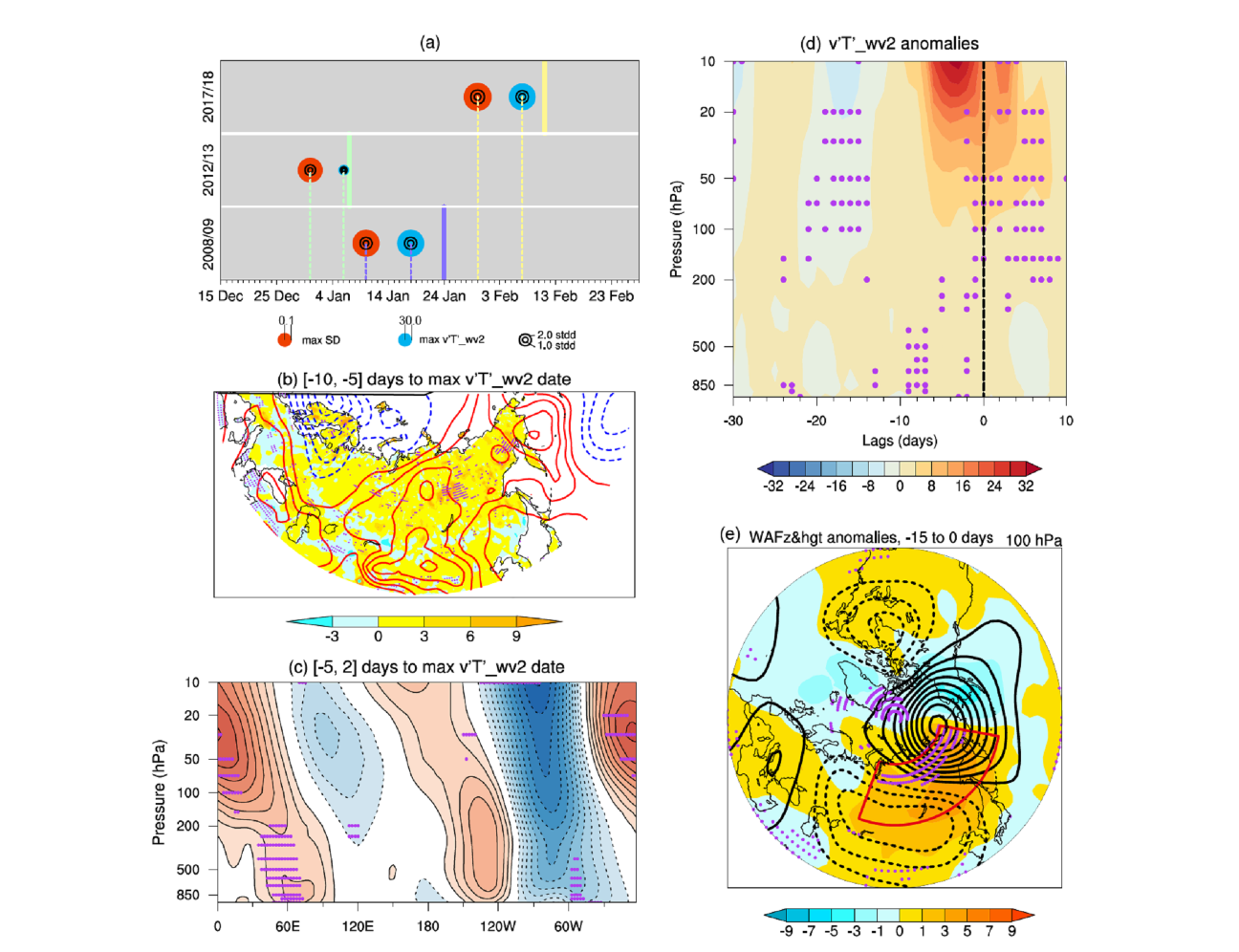联系我们
竺可桢-南森国际研究中心
邮 箱:nzc_iap@mail.iap.ac.cn
邮 编:100029
地 址:北京市朝阳区德胜门外祁家豁子华严里40号 竺南中心

科研进展
Research Progress2017/18年冬季欧洲极端冷事件、平流层爆发性增温和西伯利亚积雪关系的个例分析
Understanding of European cold extremes, Sudden Stratospheric Warming, and Siberian snow accumulation in the winter of 2017/18
[2019-12-23]【中文介绍】
平流层爆发性增温(Stratospheric Sudden Warming,SSW)是冬季平流–对流层耦合的重要体现,会对对流层的天气气候产生影响,如造成北半球中纬度地区的寒潮。关于SSW的发生机制,对流层上传的行星波是一个重要的强迫来源。在研究不同的外强迫因子对SSW的影响时,以往的研究关注较多的是海表温度,而积雪作为具有最大时空变率的地表条件,能否影响SSW的发生还尚不明确。
本文基于逐日的大气和雪深再分析资料,分析了爆发于2018年2月11日的SSW事件及其与前期西伯利亚积雪异常和后期欧洲极端冷事件的关系。本文指出,2017/18冬季西伯利亚的雪深远高于气候态同期水平,这种雪深正异常会导致东西伯利亚上空(即上传的气候态行星波最大的地区)“冷穹”增强,进而形成一个强的局地Rossby波源,上述过程对于这次SSW的爆发起到了至关重要的作用。本文还指出“积雪-分裂型SSW”联系的一些前兆的、共性的特征,包括:最大2波分量异常(100 hPa)和最大雪深异常之间约一周的时间滞后性,异常积雪场造成的偏高的海平面气压,以及“锚定”在西伯利亚上空的高脊。
冬季平流层极涡状态的早期预测对于提高包括寒潮在内的中高纬度极端天气的预测水平具有重要意义,该工作揭示的积雪增加与SSW事件的关系在一定程度上将有助于改善对积雪气候效应的理解以及次季节时间尺度的气候预测。
【英文介绍】
It is unclear whether the Eurasian snow
plays a role in tropospheric driving of sudden stratospheric warming (SSW). The
major SSW event of February 2018 is analyzed using reanalysis datasets. Here,
we demonstrate that anomalous Siberian snow accumulation could have played an
important role in the 2018 SSW occurrence. A lead-lag correlation analysis
shows that the positive fluctuating snow depth anomalies, leading to
intensified “cold domes” over eastern Siberia, i.e., in a region where the
climatological upward planetary waves maximize, precede enhanced wave-2 pulses
of meridional heat fluxes (100 hPa) by 7–8 days. The snow-SSW linkage over
2003–2019 is further investigated, and some common traits among three split
events are found. These include a time lag of about one week between the
maximum anomalies of snow depth and wave-2 pulses (100 hPa), high sea level
pressure favored by anomalous snowpack and a ridge anchoring over Siberia as
precursor of the splits. Early predictions of stratospheric polar state are
important to improve forecasts of mid-high latitude extreme weather including
cold spells. The precursory snow increases described here could potentially
improve forecast at the sub-seasonal timescale, irrespective of whether there
is causality or not between snow anomalies and occurrence of the SSW.
【关键图表】

图. (a)三个分裂型SSW事件(2017/18,
2012/13 and 2008/09)和最大积雪深度对应的发生日期、量级。(b)雪深和海平面气压, (c) 50°–70°N位势高度与纬向平均值的偏离值, (d) 纬向平均的v’T’二波分量和(e) 垂直波作用通量和位势高度的异常值的合成结果。
Figure. (a) The
occurrence of maximum snow depth (max SD) anomalies and maximum 100-hPa
v'T'_wv2 anomalies (max v’T’_wv2) in the three split SSW events (2017/18,
2012/13 and 2008/09). Composite
results for the three split
events: (b) snow
depth and SLP anomalies (c) daily-normalized anomalies of geopotential height deviation
from the zonal mean averaged over 50°–70°N (d) Time–pressure cross section of zonal-mean v’T’
anomalies of wave 2 (e) WAFz anomalies and geopotential height anomalies.
【引用格式】
Lü, Z., F. Li, Y.J. Orsolini, et al., 2020: Understanding of European Cold Extremes, Sudden Stratospheric Warming, and Siberian Snow Accumulation in the Winter of 2017/18. J. Climate, 33, 527–545.